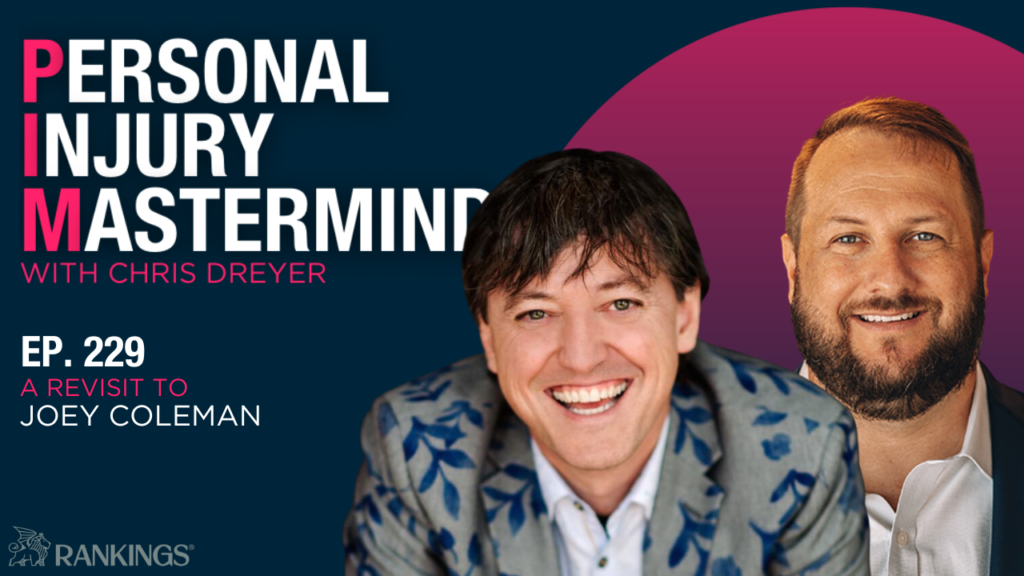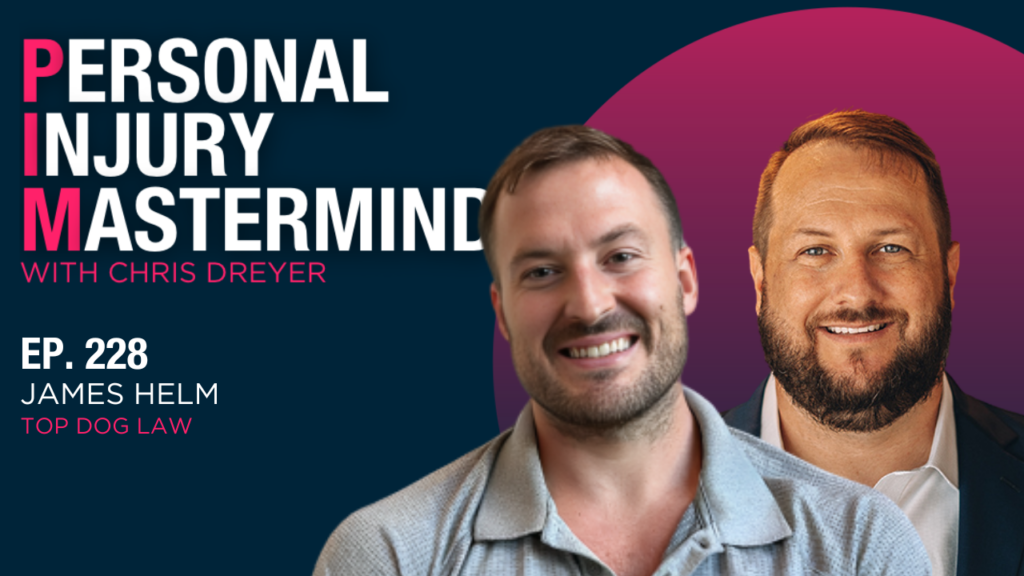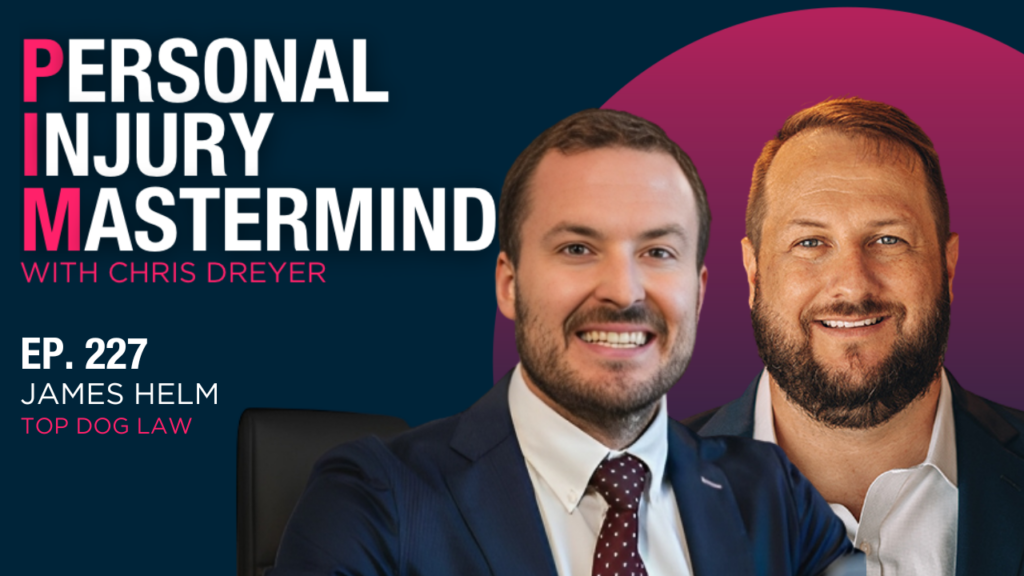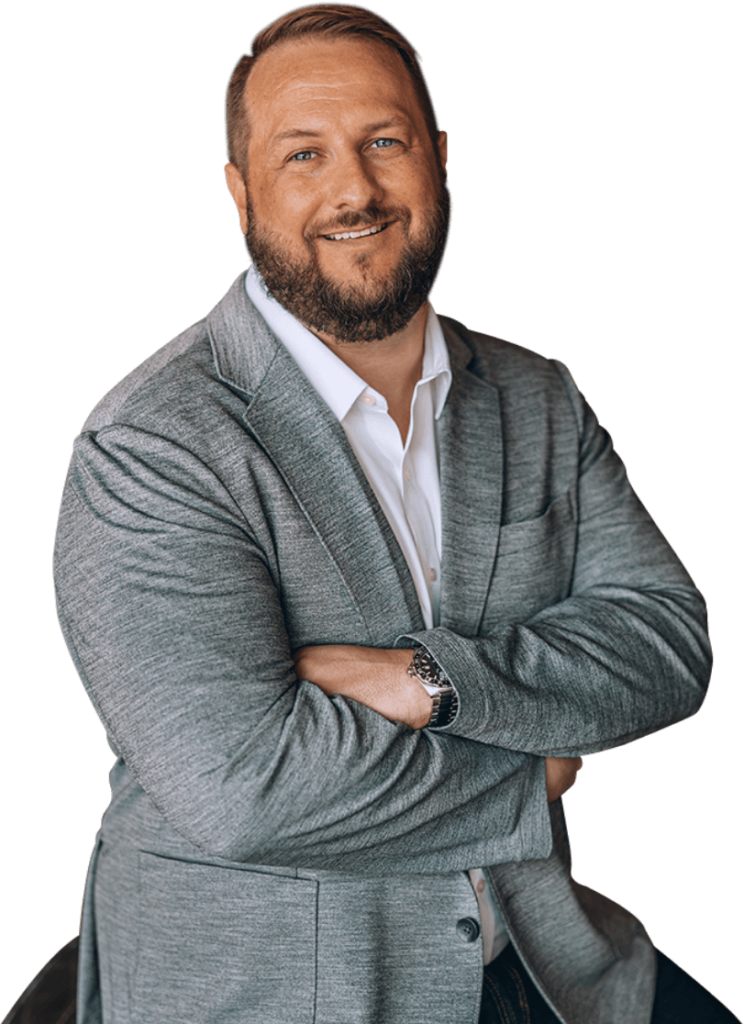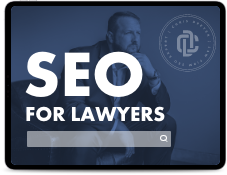Wendy Lieber
What that means is they’ve done a lot of the research.
Chris Dreyer
Give your potential clients the content they need to trust you even before they make that first call.
Wendy Lieber
70% of the purchase decision is typically made before a prospect engages with you.
Chris Dreyer
You’re listening to Personal Injury Mastermind. We give you the tools you need to take your personal injury practice to the next level. ContentBacon will make your assets sizzle. The content subscription service is owned and operated by Wendy Lieber. They serve up monthly email, blog, and social media copy that converts. Today, we talk about how to humanize content in every stage of the client journey, how to solve your customer’s pain points and what personal injury firms should be doing to get the most out of their content. I’m your host, Chris Dreyer, founder and CEO of Rankings.io. We help elite personal injury attorneys dominate first page rankings with search engine optimization. Being at the forefront of marketing is all about understanding people. So let’s get to know our guest. Here’s Wendy Lieber, founder at ContentBacon.
Wendy Lieber
So ContentBacon is my second company. I had a strategic marketing kind of more boutiquey type company first, and it was great and I grew that company, but I got to a point where the only way I was going to grow it more was to really either kind of take on an agency model, which I wasn’t super excited about, and either work harder or charge more. And I had kind of already done that. And so I was really searching for how to grow and scale a business because I really wanted to play a bigger game. And one of the things I was noticing is every company was struggling with content and digital content was becoming more and more important and necessary.
And so I started dabbling with content subscriptions with my current client base just to see what that might be like. And it was a slam dunk out of the gate. People loved it, people needed it. There was just something very distinct about the type of work I was doing that was heavy consulting, always like those heavy ROI conversations, which are fine. Whereas, with the content subscriptions, people were just happy and slept better at night knowing that they were publishing relevant content on a consistent basis. So, that’s how ContentBacon got started. I think we’re going on eight years and it was a good choice.
Chris Dreyer
Your company’s really fun on social media, talking about making stuff sizzle and all the puns with the content and bacon. That’s a lot of fun. But one of the things, and I got to be honest, and I do this for almost every firm agency vendor, the first thing I do is I get on LinkedIn and I at the company profile, I look at all the employees. And one of the things I noticed that really stood out was the amount of copywriters, not just content writers, copywriters. And so first, can you explain the difference between maybe someone that’s just writing a generic blog versus an actual copywriter?
Wendy Lieber
There’s different types of content needed to support really different stages of the customer journey. So there’s initial content that maybe more voyeuristic, people just kind of checking you out might enjoy your content. It builds awareness, but they may not necessarily ever be a customer or client or it may be they’re very early on in the process and they’re not one today. And so that might be, I consider more what you were referring to as general content. It’s strategic, but it might not necessarily be as intentional on creating a specific action.
Content that’s written, I might refer to it as conversion. Copy is what I refer to as a little bit more copywriting, where it’s very intentional, it’s very strategic, and if it’s effective or not by the result. And again, everything we do, there’s some way to measure the results. Some is a little bit maybe more fluffy, more website traffic, more social followers might be kind of more… that doesn’t pay the bills, right, but it’s part of the journey. Whereas, someone opting into something, someone raising their hand saying, I want to be part of this community, someone booking a call with you, that’s where more expertise is required for what might be referred to as copywriting.
Chris Dreyer
Yeah, and the biggest thing that I see in that persuasive style that you’re trying to convince a consumer to take action is for attorneys that have these bottom of the funnel transactional pages, these practice area pages. A lot of times they’re just really generic. They don’t highlight their USPs well, their taglines. They may on the homepage. When you get to the homepage, they may do a good job. And I do see some PI firms that do a good job of differentiating themselves there. But on the individual pages, those are sales pages. Those are where you’re trying to convince the consumer to use you versus someone else. And I see that, that’s lacking.
And also just in general in Google AdWords, ad copy and other areas where there’s a lot of direct response intention. And so that’s why I wanted to call that out specifically because your agency’s so different than just someone that’s churning out 2000 blogs per month.
Wendy Lieber
Yeah, I think the key, at least from the perspective that I look at, it’s all about being as human as possible. And I think you do that by letting your personality come through, letting your point of view come through and being more vulnerable and authentic versus trying to sell something. Although, you need to have a way for someone to buy something. So it’s not like don’t do that, but do it with a human touch. And I think to your point too, I think a lot of companies focus more on top of the funnel and then they kind of go lighter on middle and bottom, and that’s kind of where the juice is. But everyone’s always talking about more leads, more leads, more leads, but then you might have a lot of leads who you’re not nurturing, you’re not staying in touch with, even after maybe they do business with you, you’re not continuing to form a relationship with them and stay top of mind. Hopefully they won’t need you again and again.
Chris Dreyer
I hear this in a lot of different ways and no trust, and people like to do business with who they like. And I heard we had Ed Herman from Brown & Crouppen on a really early episode. He talked about brand love, you got to make them love you. And in his marketing is very unique and he stands out with three lawyers eating sandwiches or ED versus cereal and things like that. And I think it’s very creative because at the end of the day, I think standing out on social special if you’re in a legal vertical is you got to be a little bit entertaining. And so we talked a little bit about inbound marketing and attracting, engaging, delighting. And so how does inbound empower a potential client to take action?
Wendy Lieber
The beauty of having so much information available to us today is whether it’s your business, customer, or consumer, they’re doing research or they’re browsing when they want, how they want. And so it’s so important to have content to show up. Showing up is so important. We kind of put content into four buckets; educational, informational, entertaining and inspiring. And so having content that can support those pillars. So if someone is searching for a key problem that you solve, then when they find the information about you, it is kind of speaking to you. But it’s again, not trying to sell you, it’s giving you the information you need so that you can feel comfortable about making that buying decision.
There’s a really powerful statistic that I think it’s like 70-something percent of the purchase decision is typically made before a prospect engages with you. And what that means is, they’ve done a lot of the research, they’ve checked you out, they might have read testimonials, they’ve gotten to know you, so by the time they actually reach out to you, it’s really kind of yours to lose.
And that’s the beauty of content is, it’s kind of like sales lubrication because before you had to maybe actually speak to someone or use a lot of outbound marketing, TV ads, billboards, flyers to get attention and to get someone to know you, well, those things still have their place, but even if someone gets a compelling flyer in the mail, let’s see, and they’re still going to check you out, they’re still probably not going to just go right from that to picking up the phone. But they will go to your website, they will go to your social media, and if what they find there reinforces, then they’re going to take the next step. So that’s why it’s just so important.
Chris Dreyer
It really accelerates that sales cycle because they already know you. They’re ready to hire. They don’t have to be convinced once they’ve been educated, once they know they like you, now it’s just a matter of them going to your website and just picking up the phone. They’re not going to be bouncing around talking to many individuals, they’re going to just be talking to you.
Wendy Lieber
Yeah. Giving your audience as much education, kind of showing them kind of what’s behind the kimono as much as possible. There’s a saying, an educated customer is your best customer. And so I think that the more you can educate them, then again, the more they’re going to trust you because they’re like, okay, if I wanted to do this on my own, and maybe this isn’t applied to the legal space as much, but I could, but why do I want to do it on my own? It’s not the best and highest use of my time. So I’m just a big believer. And give your audience as much education, as much tools as possible so that if they want to go do it on their own, they’re armed with the best of the best. But if they want to outsource it and have it actually get done, then they’ll reach out to you.
Chris Dreyer
Wendy shares with us what personally an attorney should be doing when it comes to content.
Wendy Lieber
So I look at, there’s the foundational elements, the basics that every company should be doing to look alive, to have a presence. So obviously an up to date mobile-friendly website. That might sound like the most basic of the basics, but you’d be surprised with how many companies do not have that. And as you know, different things change and plugins get updated if you’re not staying on top of that, what might have been once mobile friendly is no longer. So making sure your website is up to date and really reflective of your firm and the personality of your firm, somehow stands out from all the others out there. And again, content is a key part of that. Whether that’s written content, video content, a combination of both, even your visuals, using stock photography versus original photography. There’s a lot of different ways to tell your story so that your site stands out from someone else and that it’s up to date.
Then I think having a section on your website for blog articles is really important. And so why do we want to have blog content? Well, blog content typically will answer the questions that your audience is potentially asking. Again, there’s some powerful statistic that 70, 80% of what gets typed into Google is in the form of a question. So if you think about what questions your audience, your prospects might have, and you address those by answering them on your site, that’s where good blog content can really help you show up and stand out from the others and talking like a human.
Again, of course a prospect wants to deal with an attorney that is professional and sounds like an attorney, but sometimes attorneys can take that in my experience a little bit too far. And again, usually they’re dealing with consumers that might not understand that lingo. So kind of breaking it down and so people can really understand it and feel comfortable is just another great way to use your blog.
And then again, social media, having a presence on the key social media sites; LinkedIn, Facebook, Twitter, Instagram, if you’re on one or all of those, and distinct on each one. So it’s not one post that you blast to all four, it’s creating content that’s native to the platform. Twitter is very different than Instagram. So again, having a strategy for your social media, some of that strategy is repurposing your blog content so you’re driving people back. Some of that might be standalone content that is again, just more helpful. But having that present so that people can see, wow, they’re active, they’re engaging, they’re posting frequently is super important.
I don’t know that this is as important for the personal injury attorney audience, but I typically will say a monthly newsletter of some sort to just go out to your database with, again, maybe it’s repurposing some of the blog content, but just a way to touch your audience on a consistent basis with really useful, helpful content so that you stay top of mind. So those are the basics. And then the next layer would be on your website, on your social media sharing, whether it’s case studies, testimonials, just more meaty type content that if someone wants to dig a layer deeper and do their research that you’re providing it for them.
Chris Dreyer
Contextualizing the social media platforms on LinkedIn, it’s more business orientation than say Instagram, it’s a little more casual in the different types of media that you place there. The other thing that I heard recently, and I heard this on a podcast, I was listening to Ed Mylett’s podcast with Alex Hormozi and he was talking about how most forms of marketing are linear equations where you just do more of them. You do more content, you have a bigger output, you do more ad spend, you do more advertising, you get more output.
Well, the thing that’s non-linear or exponential is referrals. One person introduces you to two, two introduces you to six or whatever. It’s exponential. And I think that’s where your recommendation of the newsletter really comes into play, is those are referral situations.
Wendy Lieber
Yeah, for sure.
Chris Dreyer
I think a lot of the attorneys are willing to do the execution, willing to do the writing, even roll up their sleeves and do it themselves. Maybe there’s some solo practitioners listening and they’re trying to keep their operating expenses low. So how do they come up with topics? They’re willing to write, but what do they do to come up with topics?
Wendy Lieber
I think the easiest place to start is with frequently asked questions and just think about all the questions that typically get asked during a prospect call or questions that you wish your prospects would ask you. And build a list of those and start with those as your topics. And you know, can create easy ways to do it where if an attorney maybe doesn’t want to write but is more comfortable doing an audio file where they answer the question, then get the file transcribed and then edited and make it pretty to post. There’s a lot of ways to get started, but I think the frequently asked questions is the best and easiest way, because there’s probably no shortage of those. And again, you can start with the basics and then go deeper, build deeper, and the deeper you build your content, the more you’ll stand out.
There’s strategies to show up and make sure Google finds you. And we always say, we write for humans first, search engines second. And granted, if we’re just writing for humans and no one can find us, it’s not that valuable. But I think the more that you write or create content that really is valuable for your audience, the more you’ll get rewarded. And that seems to be the trend with Google anyway, as they constantly update their algorithms, it always seems in pursuit of providing the best user experience. And so I think if you think of it that way and just really provide value to your audience, Hey, if you know could give this content to maybe your sister or family member so they would know what to do, what would that look like? And I think if you come at it from there, more the heart, then the head, you’re going to win.
Chris Dreyer
I agree with all of that, and I haven’t done this for a long time, Wendy, but there’s a directory, a legal directory called Avvo. They were acquired by internet brands. When they were at the top of the game and more visible, they had this section where consumers could ask legal questions and I would always see all the attorneys answering on platform. Well, then 8 other attorneys or 15 other attorneys would answer the same question. How much better use of their time would’ve been to just take that and turn it into a blog and put it on their own website or put it on social media? And I see that a lot and now that Google has these related questions, so it makes it a little easier there. Or you can go to a number of tools, Ahrefs or Semrush, but I still see that really not done to the full capacity that could be done.
Wendy Lieber
Yeah. They could play around with doing Facebook Lives or LinkedIn lives or their own podcast. The more you can just provide that valuable information and answer those questions… you can repurpose content too, multiple ways. You can take a podcast and turn it into show notes and social post and probably four or five blogs. And so that’s another tip is to think about how to take pieces of content and repurpose it into multiple forms so that you’re really leveraging that content and not kind of just like one and done, Oh, I did a blog, done. It’s like there’s a lot of ways to repurpose it.
Chris Dreyer
Yeah, I think Gary Vee put out a post, I think it was like a year or two ago where he said how to create, I believe it was 64 or 128 pieces of content a day. And yeah, I think the key takeaway is, you can make long form content in some manner, whether you’re speaking at a legal event or you’re hosting your own podcast or could be a long form article, and then you can just chop those up into a ton of little pieces because consumers a lot of times just don’t want to read a 30 page, a very lengthy landing page, what they would like to consume little sections of it.
Wendy Lieber
And even when you’re creating longer form content, we try to do call outs and create images with some of the key takeaways so that someone can see, hey, the research is there, there’s a meaty piece of content there, but maybe they only grab the things that we call out and they still get value.
Chris Dreyer
Dialing in the right content for the right part of the content journey can be a challenge. If you want to leave it to the experts, here’s how ContentBacon can take your firm’s content to the next level.
Wendy Lieber
So we refer to ourselves as content as a subscription, so we don’t actually refer to ourselves as an agency because we really stay in the digital content lane, so we don’t do some of the other things that a typical marketing agency might do. So we work with companies to figure out what their goals are around really those three areas; awareness, interest, decision, and put together a content subscription to support that. And that could include things like blog content, social media content, email content, as well as lead magnets, conversion kits, things that if someone’s on your site and want to opt in for something, we can provide that whole path, that whole funnel.
So subscription services are our bread and butter. That’s what we do primarily. We also can do what we refer to as Get Ready packages that are more one time projects for companies, law firms that may just need a chunk of content, a library of content to get started or get them to a certain point and then maybe they want to take it over. So we can customize a build your own to support that. But are the two key ways we work is building a subscription that supports your overall goals. We’re very much into tracking and measuring, so if we’re working with you to build awareness and interest, we’re looking at where you’re at today and tracking what’s happening so that we can either do more of what’s working, or if we’re not finding that we’re getting the results that we want or need, we can pivot and figure out how to shake it up and get it to where it’s working.
Chris Dreyer
And what’s their level of involvement? How does working with you, how does that process look?
Wendy Lieber
So we have a very thorough onboarding process and it starts out, our goal is as quickly as possible to get to know you, get to know your tone personality, get to know kind of the dos and don’ts. We worked with an attorney once who hated apostrophes. And so sometimes there’s just little nuances or words that certain firms may not want to use. So we use that onboarding process to really get to know you as quickly as possible. And so the level involvement early on is, it’s not necessarily significant, but there’s a questionnaire to fill out, there’s meetings, there’s looking at the initial content we do and providing feedback, even if it’s completely off, just being okay with letting us know why, just being super no BS with us.
But usually by month two or three we’re in a good groove. And at that point all you’re doing is reviewing, approving, and being happy. Of course, if we have certain customers that we work with who want to be more involved, and we will create situations where maybe we do a monthly interview with you and kind of do a download of all your ideas and thoughts and then turn that into content. So, there’s different ways we work with companies that fit your style and the type of involvement you want. A lot of companies we work with have pretty much put us on autopilot, so that’s also an option at a certain point where we have earned that trust where you just feel like, hey, these guys are an extension of us and I trust them, and other than maybe a monthly or quarterly deep dive call, you’re just my content’s being done and I’m happy.
Chris Dreyer
I like that you combine both the website copy with the social copy and you’re kind of hitting all the different areas and assets that you… because a lot of times it’s either or, either they’re doing website blog pages or just social. And, what’s the investment range? I know there’s different offerings, but what’s a range look like?
Wendy Lieber
Yeah. Our kind of foundational subscriptions start right around $2,200 and then they go up to whatever.
Chris Dreyer
Sky’s the limit.
Wendy Lieber
However much you want to spend just depending on the amount of content. But I would say our average subscription starting out is usually right around that 2200-2500.
Chris Dreyer
This has been amazing, Wendy, and I think you gave us a lot of value. We haven’t had very many social media and content marketers on that talk about that aspect with the website. So I think that provides a good outlet to our listeners. So one final question, what’s next for ContentBacon and where can people go to get in touch with you?
Wendy Lieber
We’re about to launch a customer facing portal for our content so that it’s a lot easier for our customers to interact with us and see where things are at any given time and interact with our team. So I’m super excited about that as well as some new product offerings that we have. So more to come on that. If you want to stay in touch, I’m always open to any conversation, so Wendy with a Y @contentbacon.com. You can find me all over social media. I have a fun content piece called Side of Bacon on LinkedIn. So yeah, any way that you want to interact with me, I’m happy to provide value and just be a resource.
Chris Dreyer
When thinking about building your content topic list, tap into FAQs and remember the four content pillars; education, information, entertainment, and inspiration. Here are the takeaways to help boost the content you already make. Your website needs to be mobile-friendly, tell a story and reflect the brand of your business. When writing content, use language that is easy to understand. Your content should be solving the pain points of your clients before they even reach out to you.
I’d like to thank Wendy from ContentBacon for sharing her story with us and I hope you gain some valuable insights from the conversation. Be sure to check out our Instagram at ContentBacon. You’ve been listening to Personal Injury Mastermind. I’m Chris Dreyer. If you like this episode, leave us a review. We’d love to hear from our listeners. I’ll catch you on next week’s PIMM with another incredible guest and all the strategies you need to master personal injury marketing.




